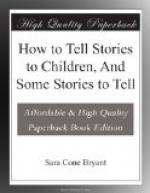It is easy to see that the dramatic part of the story and that which most pointedly illustrates the underlying idea, is the triple attempt to win the treasure,—the two failures and the one success. But this is necessarily introduced by the episode of the King of the Golden River, which is, also, an incident sure to appeal to a child’s imagination. And the regaining of the inheritance is meaningless without the fact of its previous loss, and the reason for the loss, as a contrast with the reason for its recovery. We need, then, the main facts recorded in the first three thousand words. But the West Wind episode must be avoided, not only for brevity, but because two supernatural appearances, so similar, yet of different personalities, would hopelessly confuse a told story.
Our oral story is now to be made out of a condensed statement of the character of the Valley and of its owners, and the manner of its loss; the intervention of the King of the Golden River; the three attempts to turn the river to gold, and Gluck’s success. Gluck is to be our hero, and our underlying idea is the power of love versus cruelty. Description is to be reduced to its lowest terms, and the language made simple and concrete.
With this outline in mind, it may be useful to compare the following adaptation with the original story. The adaptation is not intended in any sense as a substitute for the original, but merely as that form of it which can be told, while the original remains for reading.
THE GOLDEN RIVER[1]
[Footnote 1: Adapted from Ruskin’s King of the Golden River.]
There was once a beautiful little valley, where the sun was warm, and the rains fell softly; its apples were so red, its corn so yellow, its grapes so blue, that it was called the Treasure Valley. Not a river ran into it, but one great river flowed down the mountains on the other side, and because the setting sun always tinged its high cataract with gold after the rest of the world was dark, it was called the Golden River. The lovely valley belonged to three brothers. The youngest, little Gluck, was happy-hearted and kind, but he had a hard life with his brothers, for Hans and Schwartz were so cruel and so mean that they were known everywhere around as the “Black Brothers.” They were hard to their farm hands, hard to their customers, hard to the poor, and hardest of all to Gluck.




